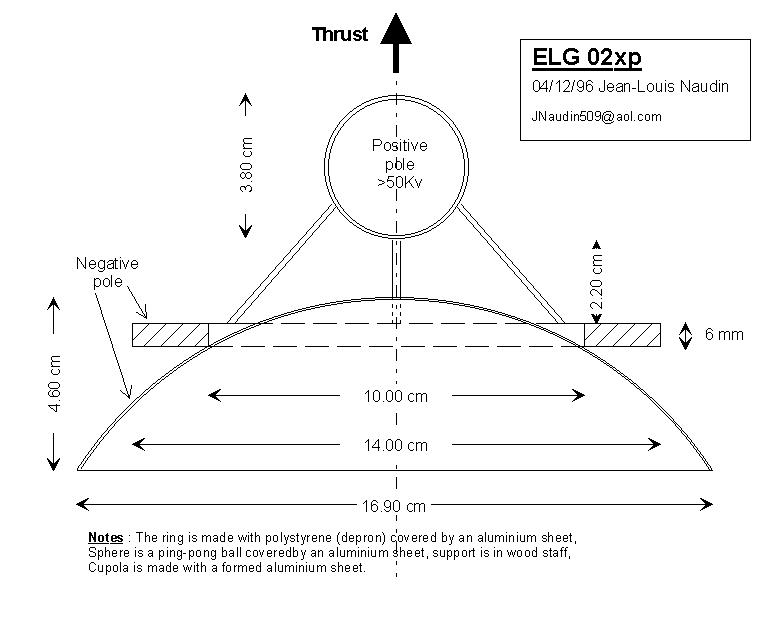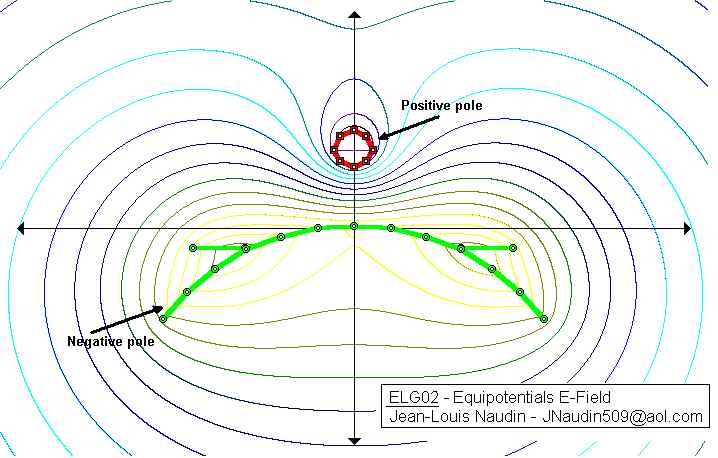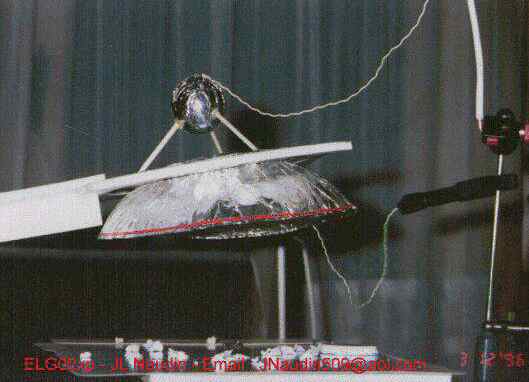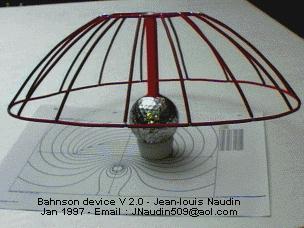
The ELG02 an Electro-AeroDynamic device
by Jean-Louis Naudin
created on 12-04-96 - JLN Labs - last update on 11-26-97

ELG02 - Description
This is a description of a method to contruct and experiment an "Electro-dynamic" device called ELG02xp.
The ELG02 device uses the directionalized non-linear Grad E like "Biefield/Brown Effect" to produce an acceleration field and this field surperimposed on the gravitational field reduces the mesured mass of this device. This experimental device shows how the Grad E field generates thrust and up to 6% weight lost.
NOTE : This device is not directely linked to the pendulum experiment from Patrick Cornille and his theory...
ELG02 - Contruction
Parts needed :
- An electrostatic generator like a Wimshurt machine or a 70Kv DC generator.
- an Aluminium sheet ( 18 microns thick / alu roller for cooking )
- an small palstic ball ( 3.8 cm diameter (ping-pong like) )
- 15 cm wood staff ( 3 mm diameter )
- a small sheet of polystyrene ( 6 mm thick like depron)
Construction steps :
1) cut a ring 14 cm (outer diameter ) and 10 cm (inner diameter) in 6 mm polystyren sheet,
2) cut 3 wood parts of 45 mm of 15 cm wood staff
3) Wrap up the 3.8 cm ball with aluminium sheet
4) Wrap up the 14 cm polystyrene ring with aluminium sheet
5) Make a cupola form with aluminium sheet on 20 cm sphere (like a hand ball)and cut it to have a 169 mm diameter cupola.
6) Glue the ring center on the cupola top
7) Glue the 3 wood parts on sphere to build a tripod support between the aluminium sphere and ring;(see figures 1)

Figure 1
Note : The space between the positive sphere must be at least 15 mm. (breakdown voltage for dry air is 4.7 Kv/mm)
Put the ELG02 device on a precision balance, the ELG02 device MUST BE ELETRICALY ISOLATED FROM THE BALANCE. Connect the sphere to POSITIVE and cupola to NEGATIVE pole of electrostatic generator.
CAUTION !!! USE EXTREME CAUTION, ALWAYS DISCHARGE AND DISCONNECT THIS DEVICE BEFORE TOUCH IT.
ELG02 - MEASURES and TESTS
I use a 250 Kv Wimshurt machine to make tests, and i limit voltage just under the breakdown between sphere and cupola.
For 70 Kv i have 5.7% weight lost of ELG02.
In these experience, I use two kinds of balances :
Firstly, I build a very sensitive balance made in Depron material (like styrofoam material). The first objective of this test has been to show an eventual thrust effect, on a completly insulated surrounding (harms, plate, ground). I have tried to optimize the shape of this device to obtain the maximum thrust.
Secondly, I put this device on a Roberval's balance (use in chemical lab's to weigh products). Plates have been insulated by 6 mm of styrofoam sheets. This is with these balance that I measure the thrust of my device.
The result is :
Device weight : 11.5 g
Thrust value : 0.66 g
Thrust % : 5.7 %
I have made different tests of electrostatic interactions :
- Influence of plate material (with aluminium plate or styrofoam plate),
- surrounding of device,
- proximity of Whimshurt machine,
- geometry and position of electrodes.
In these interactions tests, the thrust have the same magnitude and direction.

On my Whimshurt machine, I have 2 Leyden Jars. When I disconnect them, ( electrostatic field value follow closely the spinning rate of the Whimshurt machine; the thrust is proportionally to the E-Field. When I connect these Leyden Jars, E-Field is maintained and regulated, the thrust is kept until the Leyden Jars are completly discharged.
I have tried to invert the polarity of E-Field, the best thrust (always in upper direction) was obtained when the positive pole was on the top and negative pole on cupola.
My first idea was that the thrust is a resultant of ionic wind.
I conduct some experiments with the aim to know if ionic wind is the only
reason of observed thurst :
a) I spread small pieces of styrofoam on ELG02 device (cupola and ring) and I observe if ionic wind will induce particules motion : I notice only random motion due to electrostatic force, but no coordinate motion in reverse direction of thrust.
b) I put ELG02 device on plastic base with the same polystyrene particles spread on this base : Same result, no induced coordinate motion due to an eventual ionic wind.
In conclusion, I think that the ionic wind (due to to high voltage) it's not enough to induce motion of the device (thrust is sufficient to produce up to 6% weight loss).

My first test on an insulated balance ( above )
ELG03 Brown/Bahnson Test ( below )

I work closely on T.T.Brown effect and experiment these projects in my personal lab. Now, I work on Bahnson work, and studie the effect of differents shape of equipotential in non-linear grad E fields on the surrounding area. As far as I am concerned, I use the word "Electro-dynamic effect" like "electro-gravitic effect" because I am not really sure if the gravitational field is really modified with Bahnson cupola shape. By the way if we considered works of TT Brown, the force, therefore, is in a direction from the region of high flux density toward the region of low flux density, generaly in the direction through the axis of the electrode. The thrust produced by such a device is present if the electrostatic field gradient between the two electrodes IS NON-LINEAR....

Download the complete VIDEO DEMONSTRATION of the ELPEX V2.0 Experiment in Real Video file, ( if you don't have the RealPlayer 5.0, you may download it freely at : http://www.real.com/50/index.htm )
![]() Email
: JNaudin509@aol.com
Email
: JNaudin509@aol.com
Return to the Advanced Propulsions Researches page